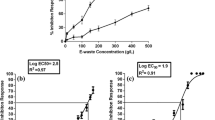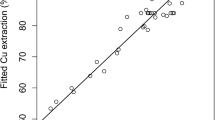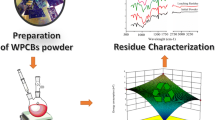Abstract
Two-step bioleaching was applied using a cyanogenic bacterium Pseudomonas balearica SAE1 to recover gold (Au) and silver (Ag) from the computer printed circuit boards (CPCBs) via central composite design of a response surface methodology (CCD-RSM). To enhance Au and Ag recovery, factors like pH level, pulp density, temperature and glycine concentration were optimized and their interactions were studied. CCD-RSM optimization resulted in 73.9 and 41.6% dissolution of Au and Ag, respectively, at initial pH 8.6, pulp density 5 g/L, temperature 31.2 °C, and glycine concentration 6.8 g/L, respectively. Two quadratic models were proposed by RSM which can be utilized as an efficient tool to predict Au and Ag recovery through bioleaching. The experimental results are in line with the predicted results, indicating reliability of RSM model in enhancing the Au and Ag recovery from CPCBs. The increased bioleaching yield of Au and Ag from discarded CPCBs has its importance in industrial e-waste recycling and safe disposal.



Similar content being viewed by others
References
Agate A (1996) Recent advances in microbial mining. World J Microbiol Biotechnol 12(5):487–495
Akcil A, Erust C, Gahan CS, Ozgun M, Sahin M, Tuncuk A (2015) Precious metal recovery from waste printed circuit boards using cyanide and non-cyanide lixiviants—a review. Waste Manag 45:258–271
Amiri F, Mousavi S, Yaghmaei S (2011) Enhancement of bioleaching of a spent Ni/Mo hydroprocessing catalyst by Penicillium simplicissimum. Sep Purif Technol 80(3):566–576
Amiri F, Mousavi S, Yaghmaei S, Barati M (2012) Bioleaching kinetics of a spent refinery catalyst using Aspergillus niger at optimal conditions. Biochem Eng J 67:208–217
Arshadi M, Mousavi S (2014) Simultaneous recovery of Ni and Cu from computer-printed circuit boards using bioleaching: statistical evaluation and optimization. Bioresour Technol 174:233–242
Arshadi M, Mousavi S (2015) Enhancement of simultaneous gold and copper extraction from computer printed circuit boards using Bacillus megaterium. Bioresour Technol 175:315–324
Arshadi M, Mousavi S, Rasoulnia P (2016) Enhancement of simultaneous gold and copper recovery from discarded mobile phone PCBs using Bacillus megaterium: RSM based optimization of effective factors and evaluation of their interactions. Waste Manag 57:158–167
Brandl H, Faramarzi MA (2006) Microbe–metal-interactions for the biotechnological treatment of metal-containing solid waste. China Part 4(2):93–97
Brandl H, Bosshard R, Wegmann M (2001) Computer-munching microbes: metal leaching from electronic scrap by bacteria and fungi. Hydrometallurgy 59(2):319–326
Brandl H, Lehmann S, Faramarzi MA, Martinelli D (2008) Biomobilization of silver, gold, and platinum from solid waste materials by HCN-forming microorganisms. Hydrometallurgy 94(1):14–17
Faramarzi MA, Stagars M, Pensini E, Krebs W, Brandl H (2004) Metal solubilization from metal-containing solid materials by cyanogenic Chromobacterium violaceum. J Biotechnol 113(1):321–326
Ilyas S, Anwar MA, Niazi SB, Ghauri MA (2007) Bioleaching of metals from electronic scrap by moderately thermophilic acidophilic bacteria. Hydrometallurgy 88(1):180–188
Işıldar A, van de Vossenberg J, Rene ER, van Hullebusch ED, Lens PN (2016) Two-step bioleaching of copper and gold from discarded printed circuit boards (PCB). Waste Manag 57:149–157
Jujun R, Xingjiong Z, Yiming Q, Jian H (2014) A new strain for recovering precious metals from waste printed circuit boards. Waste Manag 34(5):901–907
Kaya M (2016) Recovery of metals and nonmetals from electronic waste by physical and chemical recycling processes. Waste Manag 57:64–90
Kumar V, Chauhan RS, Sood H, Tandon C (2015) Cost effective quantification of picrosides in Picrorhiza kurroa by employing response surface methodology using HPLC-UV. J Plant Biochem Biotechnol 24(4):376–384
Kumar A, Holuszko M, Espinosa DCR (2017a) E-waste: an overview on generation, collection, legislation and recycling practices. Resour Conserv Recycl 122:32–42
Kumar A, Saini HS, Kumar S (2017b) Bioleaching of gold and silver from waste printed circuit boards by Pseudomonas balearica SAE1 isolated from an e-waste recycling facility. Curr Microbiol. https://doi.org/10.1007/s00284-017-1365-0
Liang G, Mo Y, Zhou Q (2010) Novel strategies of bioleaching metals from printed circuit boards (PCBs) in mixed cultivation of two acidophiles. Enzyme Microb Technol 47(7):322–326
Manikan V, Kalil MS, Hamid AA (2015) Response surface optimization of culture medium for enhanced docosahexaenoic acid production by a Malaysian thraustochytrid. Sci Rep 5:8611
Natarajan G, Ting YP (2014) Pretreatment of e-waste and mutation of alkali-tolerant cyanogenic bacteria promote gold biorecovery. Bioresour Technol 152:80–85
Natarajan G, Ting YP (2015) Gold biorecovery from e-waste: an improved strategy through spent medium leaching with pH modification. Chemosphere 136:232–238
Pradhan JK, Kumar S (2012) Metals bioleaching from electronic waste by Chromobacterium violaceum and Pseudomonads sp. Waste Manage Res 30(11):1151–1159
Pradhan JK, Kumar S (2014) Informal e-waste recycling: environmental risk assessment of heavy metal contamination in Mandoli industrial area, Delhi, India. Environ Sci Pollut Res 21(13):7913–7928
Priya A, Hait S (2017) Comparative assessment of metallurgical recovery of metals from electronic waste with special emphasis on bioleaching. Environ Sci Pollut Res 24(8):6989–7008
Rozas EE, Mendes MA, Nascimento CA, Espinosa DC, Oliveira R, Oliveira G, Custodio MR (2017) Bioleaching of electronic waste using bacteria isolated from the marine sponge Hymeniacidon heliophila (Porifera). J Hazard Mater 329:120–130
Sahni A, Kumar A, Kumar S (2016) Chemo-biohydrometallurgy—a hybrid technology to recover metals from obsolete mobile SIM cards. Environ Nanotechnol Monit Manage 6:130–133
Shin D, Jeong J, Lee S, Pandey B, J-c Lee (2013) Evaluation of bioleaching factors on gold recovery from ore by cyanide-producing bacteria. Miner Eng 48:20–24
Sun ZHI, Xiao Y, Sietsma J, Agterhuis H, Visser G, Yang Y (2015) Characterisation of metals in the electronic waste of complex mixtures of end-of-life ICT products for development of cleaner recovery technology. Waste Manag 35:227–235
Sun Z, Cao H, Xiao Y, Sietsma J, Jin W, Agterhuis H, Yang Y (2017) Toward sustainability for recovery of critical metals from electronic waste: the hydrochemistry processes. ACS Sustain Chem Eng 5(1):21–40
Tansel B (2017) From electronic consumer products to e-wastes: global outlook, waste quantities, recycling challenges. Environ Int 98:35–45
Tuncuk A, Stazi V, Akcil A, Yazici EY, Deveci H (2012) Aqueous metal recovery techniques from e-scrap: hydrometallurgy in recycling. Miner Eng 25(1):28–37
Willner J, Fornalczyk A (2013) Extraction of metals from electronic waste by bacterial leaching. Environ Prot Eng 39(1):197–208
Xiang Y, Wu P, Zhu N, Zhang T, Liu W, Wu J, Li P (2010) Bioleaching of copper from waste printed circuit boards by bacterial consortium enriched from acid mine drainage. J Hazard Mater 184(1):812–818
Acknowledgements
The authors acknowledge financial support provided by Department of Biotechnology (BT/PR7478/BCE/8/951/2013). We are also grateful to Exigo Industry for providing e-waste.
Author information
Authors and Affiliations
Corresponding author
Ethics declarations
Conflict of interest
No conflicts of interest.
Rights and permissions
About this article
Cite this article
Kumar, A., Saini, H.S. & Kumar, S. Enhancement of gold and silver recovery from discarded computer printed circuit boards by Pseudomonas balearica SAE1 using response surface methodology (RSM). 3 Biotech 8, 100 (2018). https://doi.org/10.1007/s13205-018-1129-y
Received:
Accepted:
Published:
DOI: https://doi.org/10.1007/s13205-018-1129-y




